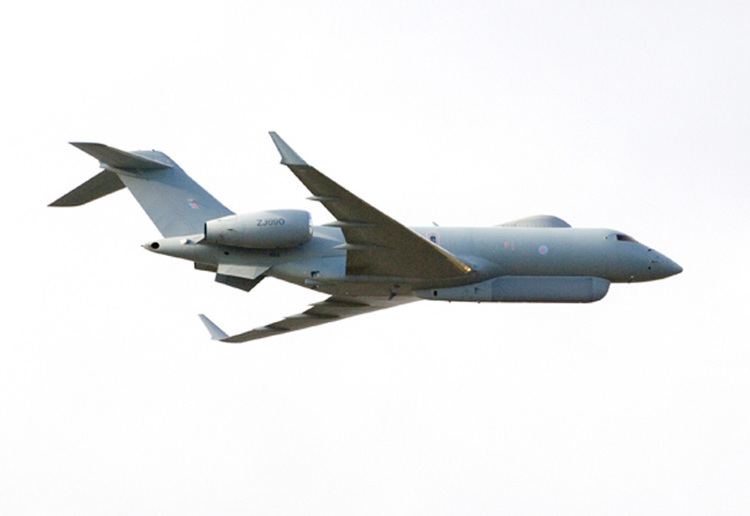Top speed 950 km/h Length 30 m Weight 24,000 kg | Range 9,250 km Wingspan 28 m Engine type Rolls-Royce BR700 | |
 | ||
Manufacturers Raytheon, Bombardier Aerospace | ||
Raf raytheon sentinel surveillance
The Raytheon Sentinel is an airborne battlefield and ground surveillance aircraft operated by the Royal Air Force. Based on the Bombardier Global Express ultra long range business jet, it was adapted by Raytheon to meet the RAF's requirements. Originally known as the ASTOR (Airborne STand-Off Radar) programme the aircraft is operated by a RAF squadron manned by both air force and army personnel. The Sentinel is interoperable with other allied systems such as JSTARS and the NATO Alliance Ground Surveillance (AGS) system.
Contents
- Raf raytheon sentinel surveillance
- Raytheon sentinel video award 2013
- Design and development
- Operational history
- Operators
- Specifications
- References
In 2010 the UK Conservative-Liberal Democrat coalition government's Strategic Defence and Security Review announced its intention to "withdraw the Sentinel airborne ground surveillance aircraft once it is no longer required to support operations in Afghanistan." Sentinel has supported the British Army in Afghanistan. One Sentinel aircraft was deployed to assist French forces in Mali on 25 January 2013. The 2010 decision was reversed in 2014 by Prime Minister David Cameron and in the 2015 SDSR, the British government announced that the type's retirement would be delayed and that it would remain in service "into the next decade".

Raytheon sentinel video award 2013
Design and development

ASTOR has its roots in the British Army's Corps Airborne Stand-Off Radar (CASTOR) programme which in 1984 modified a Britten-Norman Islander (G-DLRA/ZG989) with a large nose radome for battlefield surveillance. The 1991 Gulf War confirmed the requirement for such an aircraft, but the end of the Cold War made funding difficult. The production contract was signed in December 1999 with a projected in-service date of 2005.

The Sentinel R1 is a modified Bombardier Global Express powered by two Rolls-Royce BR700 turbofan engines. The programme involved five aircraft and eight mobile ground stations (six on wheeled all terrain vehicles and two in air transportable containers), and a training facility at RAF Waddington. The programme cost £850m, as budgeted. The support contract is for 3200 flying hours per year and between 2015–18 the fleet of five aircraft will have average running costs of £54.4m/year.
The Sentinel cockpit has a centrally housed, pull-down screen capable of displaying a moving map, Link 16 datalink information and defensive aids subsystem (DASS) data. The DASS comprises a towed radar decoy, missile approach warning system and chaff and flare dispensers and can be operated in automatic, semi-automatic or manual mode.
The aircraft normally operates at over 40,000 feet (12,000 m) to ensure a high resolution view of a large battlefield area. It is crewed by a pilot, a co-pilot, an Airborne Mission Commander (AMC) and two image analysts. Mission endurance is approximately nine hours. While the image analysts can analyse the images on board the aircraft it is expected that, unlike the JSTARS, the actual battle management will occur on the ground.
The main radar is a Raytheon Systems/BAE Systems dual-mode synthetic aperture radar / moving target indication (SAR/MTI) radar known as Sentinel Dual Mode Radar Sensor (DMRS). It uses AESA active electronically scanned array technology. Raytheon claim it could be modified to match the maritime surveillance capability of the cancelled Nimrod MRA4, and the ground stations could be adapted to receive data from Watchkeeper, MQ-9 Reaper and the future Scavenger programme. A contract for the development of a maritime capable software upgrade will be placed in the spring of 2015; Jane's speculates that this would allow the Sentinel to detect surface vessels and potentially submarine periscopes and that other sensors could be fitted as a 'low-end' capability for maritime surveillance to complement a 'high-end' platform such as the P-8A Poseidon.
Operational history
The first flight of the modified prototype was in August 2001, which validated the modifications required for the ASTOR system. The first production Sentinel R1 made its 4.4-hour maiden flight on 26 May 2004.
The aircraft entered operational service with V (Army Co-operation) Squadron of the Royal Air Force based at RAF Waddington and flew its first operational sortie in Afghanistan in February 2009.
In 2010 the UK government's Strategic Defence and Security Review announced its intention to "withdraw the Sentinel airborne ground surveillance aircraft once it is no longer required to support operations in Afghanistan." Sentinel has supported the British Army in Afghanistan. Its role above Libya in 2011 was described as "pivotal" by the head of the RAF. In February 2012 it was announced that Sentinel would be offered as the UK contribution to NATO's Alliance Ground Surveillance (AGS) collaboration, complementing NATO RQ-4 Global Hawks and French Heron TPs.
On 25 January 2013, the British Government announced that the RAF would deploy one Sentinel aircraft from RAF Waddington, in support of French operations in Mali. On 14 February 2014, it was reported that the Sentinel was used to map the scale of flooding in Southern England. On 18 May 2014, the MOD announced that a Sentinel had departed to Ghana to assist in the search for the 223 schoolgirls abducted by the Islamic militant group, Boko Haram, in Nigeria on 14 April 2014. En route to Ghana the Sentinel was forced to divert to Senegal due to a technical issue.
In 2014, Prime Minister David Cameron announced the retention of the aircraft, even after operations end in Afghanistan in the fall of 2018.
On 26 March 2015, the MOD announced the deployment of two Sentinel aircraft to provide surveillance to coalition forces fighting as part of the Military intervention against ISIL. During this campaign, the R1 earned the moniker "Boil Lancer" due to the rounded appearance of its radar pods and it's similarity to the B-1 Lancer in terms of size and coloration.
Operators
Specifications
Data from Royal Air Force
General characteristics
Performance
